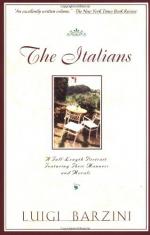“Here,” said the cavaliere, standing in the centre under the dome, “is the chapel of the Trenta. Here I, Cesare Trenta, fourteenth in succession from Gaultiero Trenta—who commanded a regiment at the battle of Marignano against the French under Francis I.—hope to lay my bones. The altar, as you see, is sanctified by the possession of an ancestral picture, deemed miraculous.” He bowed to the earth as he spoke, in which example he was followed by Enrica and Baldassare. “San Riccardo was the companion-in-arms of Godfrey de Bouillon. His bones lie under the altar. Upon his return from the crusades he died in our palace. We still show the very room. His body is quite entire within that tomb. I have seen it myself when a boy.”
Even the count did not venture to raise any doubt as to the authenticity of the patron saint of the Trenta family. The cavaliere himself was on his knees; rosary in hand, he was devoutly offering up his innocent prayers to the ashes of an imaginary saint. After many crossings, bowings, and touchings of the tomb (always kissing the fingers that had been in contact with the sanctified stone), he arose, smiling.
“And now,” said the count, turning toward Enrica, “I will ask leave to show you another tomb, which may, possibly, interest you more than the sepulchre of the respected Trenta.” As he spoke he led her to the opposite aisle, toward a sarcophagus of black marble placed under an arch, on which was inscribed, in gilt letters, the name “Castruccio Castracani degli Antimelli,” and the date “1328.” “Had our Castruccio moved in a larger sphere,” said the count, addressing the little group that had now gathered about him, “he would have won a name as great as that of Alexander of Macedon. Like Alexander, he died in the flower of his age, in the height of his fame. Had he lived, he would have been King of Italy, and Lucca would have become the capital of the peninsula. Chaste, sober, and merciful—brave without rashness, and prudent without fear—Castruccio won all hearts. Lucca at least appreciated her hero. Proud alike of his personal qualities, and of those warlike exploits with which Italy already rang, she unanimously elected him dictator. When this signal honor was conferred upon him,” continued the count, addressing himself again specially to Enrica, who listened, her large dreamy eyes fixed upon him, “Castruccio was absent, engaged in one of those perpetual campaigns against Florence which occupied so large a portion of his short life. At that very moment he was encamped on the heights of San Miniato, preparing to besiege the hated rival of our city—broken and reduced by the recent victory he had gained over her at Altopasso. At Altopasso he had defeated and humiliated Florence. Now he had planted our flag under her very walls. Upon the arrival of the ambassadors sent by the Lucchese Republic—one of whom was a Guinigi—”




